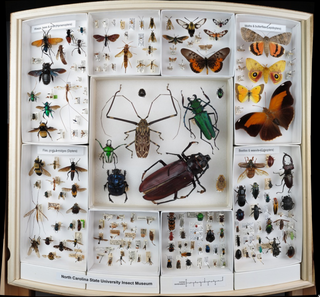
Entomology is the scientific study of insects, a branch of zoology. In the past the term insect was less specific, and historically the definition of entomology would also include the study of animals in other arthropod groups, such as arachnids, myriapods, and crustaceans. This wider meaning may still be encountered in informal use.

The University of Kansas Natural History Museum is part of the University of Kansas Biodiversity Institute, a KU designated research center dedicated to the study of the life of the planet.

Charles Duncan Michener was an American entomologist born in Pasadena, California. He was a leading expert on bees, his magnum opus being The Bees of the World published in 2000.
An insectarium is a live insect zoo, or a museum or exhibit of live insects. Insectariums often display a variety of insects and similar arthropods, such as spiders, beetles, cockroaches, ants, bees, millipedes, centipedes, crickets, grasshoppers, stick insects, scorpions, mantises and woodlice. Displays can focus on learning about insects, types of insects, their habitats, why they are important, and the work of entomologists, arachnologists, and other scientists that study terrestrial arthropods and similar animals.
Irene Moon is an American entomologist, performance artist, musician, playwright, actor, and filmmaker. She has published in the field of entomology as Katja Seltmann, and is the current director of the Cheadle Center for Biodiversity and Ecological Restoration at the University of California, Santa Barbara.

The Cheadle Center for Biodiversity and Ecological Restoration (CCBER) is a research center under the Office of Research at the University of California, Santa Barbara (UCSB) whose mission is to preserve regional biodiversity and restore ecosystems on campus lands. CCBER has three main functions: curation and preservation of natural history collections, native coastal ecosystem and habitat restoration on campus lands, and education and outreach for both UCSB students and local community schools.

The NCSU Insect Museum is the center for research and training in insect systematics and biodiversity informatics at North Carolina State University. The Museum's collections hold more than 1.5 million specimens, with major emphases on the insects of North Carolina and on the Auchenorrhyncha and Aphididae (Hemiptera) of the world. A smaller but historically important part of the collection is dedicated to Hymenoptera.

The Beaty Biodiversity Museum is a natural history museum in Vancouver, British Columbia, Canada, located on the campus of the University of British Columbia. Its 20,000 square feet of collections and exhibit space were first opened to the public on October 16, 2010; since then it has received over 35,000 visitors per year.

Megalara garuda, colloquially referred to as the "King of Wasps", is a large wasp and the only species in the genus Megalara, family Crabronidae, tribe Larrini. The species M. garuda is only known from the Mekongga Mountains in the southeastern part of the Indonesian island of Sulawesi. It was described in 2012 by Lynn Kimsey, director of the Bohart Museum of Entomology and professor of entomology at the University of California, Davis, and Michael Ohl, curator and head of entomology at the Museum für Naturkunde, Berlin. Rosichon Ubaidillah from the Indonesian Institute of Sciences also contributed the discovery.
Lynn Kimsey is an entomologist, taxonomist, director of the Bohart Museum of Entomology and professor of entomology at the University of California, Davis since 1989. Her specialties are bees and wasps; and insect diversity and evolution.
Richard Mitchell Bohart was an American entomologist, university professor, and a member of the University of California, Davis Department of Entomology for more than 50 years. He taught courses in general entomology, insect systematics, and summer field courses in insect identification. From 1963 to 1967 he served as chair of the Department of Entomology for the University of California at Davis.
The Essig Museum of Entomology is a research museum dedicated to terrestrial arthropods, located at the University of California at Berkeley. It contains perhaps the world's largest collection of California insects and has been ranked among the top university-based collections in North America. The museum is open to the public twice per year.

Rosemary Gillespie is an evolutionary biologist and professor of Environmental Science, Policy & Management, Division of Insect Biology at the University of California, Berkeley. She was the President of the American Genetics Association in 2018 and was previously President of the International Biogeography Society 2013–2015. From 2011 to 2013 she had served at the president of the American Arachnological Society. As of 2020 she is the faculty director of the Essig Museum of Entomology and a Professor and Schlinger Chair in systematic entomology at the University of California, Berkeley. Gillespie is known for her work on the evolution of communities on hotspot archipelagoes.

The Frost Entomological Museum is an active research institution, associated with the Pennsylvania State University's flagship campus in University Park, PA. The museum houses a research collection, estimated at 1.3 million arthropod specimens, and a public exhibition and educational space. Although the museum was founded in 1969, much of the collection dates to the early 1900s and even the late 1800s.

The conservation and restoration of insect specimens is the process of caring for and preserving insects as a part of a collection. Conservation concerns begin at collection and continue through preparation, storage, examination, documentation, research and treatment when restoration is needed.

Jessica Lee Ware is a Canadian-American evolutionary biologist and entomologist. She is the associate curator of invertebrate zoology at the American Museum of Natural History in New York City. In addition, she is a principal investigator at the Sackler Institute for Comparative Genomics and an associate professor for the Richard Gilder Graduate School.

Loboscelidiinae is a small subfamily of cuckoo wasps in the family Chrysididae. There are 2 genera and more than 40 described species in Loboscelidiinae, and they are parasitoids of walking stick eggs.

The Lincoln University Entomology Research Collection is a collection of approximately 500,000 insect, spider, and other arthropod specimens housed in Lincoln University, New Zealand. Being one of New Zealand's largest insect research collections, it is the only one based in a university.

The UPLB Museum of Natural History is a natural science and natural history museum within the University of the Philippines Los Baños (UPLB) campus. It serves as a center for documentation, research, and information of flora and fauna of the Philippines. The museum is one of the research and extension units of the UPLB and its role parallels that of a library for written records.

Dr. Bruce Hammock is an American entomologist, chemist and toxicologist. He is known for his research regarding improving pest control agents, monitoring and determining the human and environmental health effects of pesticides and in medicine work on the inflammation resolving branch of the arachidonate cascade leading to a drug candidate to treat pain and inflammatory disease. Additionally, he made many advances in U.S. agriculture which led to him receiving the Frasch and Spencer Awards of the ACS and the Alexander von Humboldt Award in Agriculture. His early work tested the basic hypothesis in both insects and mammals that regulation of chemical mediators could be as much by specific degradation as by biosynthesis. He exploited this fundamental knowledge both in agriculture and in human pharmacology.

















